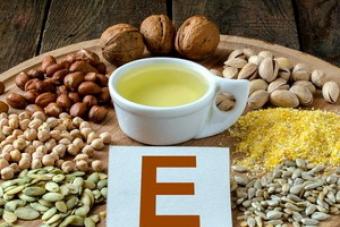Dietary (plant) fibers are components plant food- vegetables, fruits, berries, grain processing products. Dietary fibers include cellulose, hemicellulose, pectin and others. Together with proteins, they form the walls of plant cells.
Cellulose (fiber)- the most studied structural material of cells. Many celluloses are contained in the shells of the grain. Wheat and rye bran- cellulose concentrates.
Hemicelluloses belong to the group of polysaccharides. In terms of their content in plant products and their prevalence, they are second only to cellulose.
pectin substances found in vegetables, fruits and berries, are in the form of protopectin and pectin. unripe fruits contain protopectin, insoluble in water, which, when the fruit ripens, turns into soluble pectin. Protopectin splits and passes into pectin also during the heat treatment of fruits.
Dry food pectin is obtained from apple pomace, beet pulp. They enrich pilaf, canned food from eggplant caviar, pepper, with vegetables, fruit purees, marshmallows, jelly marmalade, etc.
lignin- non-carbonaceous substance - the supporting part of the cells, contained in the dietary fibers of various plants.
Dietary fiber companions are proteins, phytic (inosittriphosphoric) acid, lipids, macro- and microelements. Fiber and pectin are not broken down by enzymes digestive system, but under the influence of normal intestinal microflora cellulose, hemicellulose and pectin are broken down, turning into monosaccharides, volatile organic acids - acetic, propionic, butyric and other substances used by the body.
Hemicelluloses are more sensitive to bacterial digestion than cellulose. Pectin is most fully decomposed, and lignin is the worst. On average, intestinal enzymes digest 68% of cellulose, 95% of hemicellulose and most of the pectin. It is believed that the digestion of half of the dietary fiber is carried out with the help of the microflora of the large intestine.
For a long time, dietary fiber was considered unnecessary ballast for humans. Modern research indicate that dietary fiber is necessary to ensure the normal functioning of the human body, both healthy and sick. It has been proven that metabolic disorders are often associated with a lack of dietary fiber in the diet.
Dietary fiber has the ability to retain moisture. Swelling, they have a positive effect on the activity of the intestines: they speed up the passage of food through the intestines, facilitate the emptying of the intestines. More moisture is retained by dietary fibers of bran, less - by carrots, apples, eggplants, cabbage, pears, green peas.
Grain fibers are especially valuable, since they are insensitive to bacterial digestion and serve as a source of formation of organic acids.
Lignin increases the stability of dietary fiber. Fiber, hemicellulose, pectin, lignin, stimulating peristalsis ( contractile function) intestines, prevent the occurrence of constipation. The consumption of bread is predominantly wheat flour fine grinding, containing little fiber, as well as not enough plant products leads to diseases of the colon, diverticulitis (sac-like protrusion of the intestinal wall), the formation of polyps and even the occurrence of colon cancer.
It has been studied that colon cancer often occurs with a deficiency of plant products in the diet, the predominant use of meat, eggs, animal fats and refined (purified) products - bread and pasta from wheat flour of the highest grades, which contain almost no dietary fiber. Such nutrition leads to weak intestinal motility. To the occurrence of constipation, longer contact of the intestines with feces, which may contain carcinogenic substances that are formed in the intestines during metabolism or when eating food containing these substances.
Dietary fiber stimulates the secretion of bile, preventing its stagnation, normalizes the function of the biliary tract. They affect the metabolism of cholesterol, regulate the absorption of nutrients. The ability of dietary fiber to reduce the level of glucose and cholesterol in the blood has been revealed.
Deficiency of dietary fiber in the diet is a factor in the development of atherosclerosis, diabetes, cholelithiasis.
Pectins have the ability to bind in the gastrointestinal tract heavy metals- lead, mercury, cadmium, chromium, zinc, cobalt, etc., as well as radionuclides. Therefore, they are used in therapeutic and prophylactic nutrition. Pectins as antitoxic food components are also recommended for workers working in conditions of temporary radioactive contamination.
It should also be noted that dietary fiber has a beneficial effect on the development of beneficial intestinal microflora, without which the synthesis of hormones, vitamins, amino acids and other biologically active substances is inhibited.
Pectins are found in fruits, vegetables, root crops and other plant products in the amount of 0.5-13.8%. The most rich in pectin are table beets, radishes, carrots, sweet peppers, pumpkins, eggplants, apples, apricots, quince, cherries, plums, pears, citrus fruits. Many pectins in fruit and vegetable dishes with pulp, fruits and berries, mashed with sugar. Use in summer and autumn fresh vegetables, fruits and berries. A lot of fiber is found in legumes (3.9-5.7%), grains (2.3%), oatmeal(2.8%), carrots and pumpkins (1.2%), beets (0.9%), potatoes and white cabbage(1.0%), eggplant (1.3%), oranges (1.4%), tomatoes (1.2%), buckwheat (1.1%), rye bread (1.1%), wheat bread whole grains (2.0%). Not a large number of fiber contains wheat bread from flour of the 2nd grade (0.4%), pasta from flour premium(0.1%), bakery products from flour of the 2nd grade (0.2%) and semolina (0,2%).
And indigestible starch combine into one common group nutrients which are called dietary fiber.
Alimentary fiber - these are edible components of food, mainly of a plant nature, not digested and not absorbed in small intestine, but fully or partially fermented (splitting) in the large intestine. E then one of critical components food. During the development of the theory balanced nutrition dietary fiber was assigned the role of a ballast, unnecessary substance, on the sole basis that they are practically not digested and absorbed by the human gastrointestinal tract. There were also attempts to cleanse food of "unnecessary" fiber in order to increase nutritional value products, and this practice, as it turned out, turned out to be vicious.
Currently, the importance of the presence of dietary fiber in the human diet is absolutely recognized.
insoluble dietary fiber
The insoluble dietary fibers are cellulose and lignin. Cellulose is a polysaccharide that
at complete hydrolysis produces glucose, but this does not occur in the human gastrointestinal tract. Lignin is not a carbohydrate and has a complex chemical structure and is a mixture of aromatic polymers.
Insoluble dietary fiber, supplied with food, swells in acidic environment stomach and is an excellent adsorbent that removes bile acids, allergens and other harmful substances located in the digestive tract.
Cellulose serves as a habitat for symbiont microorganisms - bacteria that live in the human intestine. They are involved in the digestion of food, synthesize some B groups, and prevent the reproduction of pathogenic and conditionally pathogenic microflora.
As a result of the fermentation of dietary fibers by the normal microflora of the large intestine, gases (hydrogen, carbon dioxide, methane) and some gases (propionic, acetic, butyric) are formed. These products, resulting from fermentation, are involved in maintaining the vital activity of the intestinal microflora and are involved in the metabolism of the cells of the mucous membrane of the large intestine. Short-chain fatty acids are absorbed by the cells of the mucous membrane and metabolized with the release of the necessary energy (up to 2 kcal per 1 g of dietary fiber). In addition, butyric acid is used by cells of the colonic mucosa and plays a role in protecting the colonic epithelium from various pathological processes, including tumors.
Cellulose, passing through digestive tract, irritates its walls and stimulates intestinal motility, thereby preventing constipation and accelerating excretion from the large intestine toxic substances, received with food and or excreted from the body with bile.
Soluble fiber
Soluble fiber - pectin (from fruits), resin (from legumes), alginase (from various seaweed) and helicellulose (from barley and oats). Like cellulose, it is an adsorbent and in this their role is identical. Pectin in the presence of water turns into jelly and quickly fills the stomach, thereby contributing to a quick feeling of fullness, which is currently actively used by nutritionists.
Soluble fiber, like insoluble fiber, creates favorable environment habitat for beneficial microorganisms symbionts.
The daily requirement of the body for fiber is at least twenty-five grams.
Foods rich in fiber
1. Raw fruits: prunes, apples, fresh plums, pears, bananas, oranges, lemons, grapefruits, apricots (dried apricots, apricots), all dried fruits, raisins, strawberries, peaches.
2. Raw vegetables: peas, parsley, dill, cilantro, cabbage, zucchini, pumpkin, celery, carrots, beets, tomatoes, cucumbers.
3. Nuts: almonds, hazelnuts, walnuts, peanuts, white seeds and others. They are best digested with green vegetables.
4. Bread made from whole grains, bran, sprouts, oat flakes, buckwheat, corn grits, bran.
| Zucchini | Pumpkin | garden strawberry | |||||
| White cabbage | Melon | cranberry | |||||
| cauliflower | Watermelon | raspberries | |||||
| potato | gooseberry | ||||||
| green peas | Dried apricots | Red currants | |||||
| green onion | Dried apricots | black currant | |||||
| leek | cherry plum | rowan garden | |||||
| onion | garden plum | chokeberry | |||||
| Carrot | prunes | turn | |||||
| ground cucumbers | Cherry | blackberry | |||||
| greenhouse cucumbers | Pear | rosehip fresh | |||||
| sweet bell pepper | peach | dried wild rose | |||||
| parsley (greens) | cherries | ground tomatoes | |||||
| parsley (root) | apples | greenhouse tomatoes | |||||
| Beet | Orange | Dill | |||||
| celery (greens) | grapefruit | nuts | |||||
| celery (root) | Lemon | oatmeal | |||||
| (pod) | mandarin | buckwheat | |||||
| grape | cowberry | pearl barley | |||||
| bran wheat bread | |||||||
| fresh mushrooms | |||||||
| dried mushrooms |
All modern nutritionists recommend including in your menu as much dietary fiber as possible (other names are fiber, ballast, indigestible or indigestible carbohydrates). Benefits of these substances human body, it is difficult to overestimate. In this article, we will analyze the benefits of dietary fiber and what are their main sources.
Types of dietary fiber
Fiber - these are which do not give the body energy, but perform a number of important functions. It is divided into two types:
The benefits of fiber
Products containing dietary fiber, both insoluble and soluble, must be present in the daily diet. Fiber prevents the formation of stones in gallbladder and helps lower blood cholesterol levels. In addition, dietary fiber cleanses the body of toxic compounds, quickly saturates without extra calories. With the regular use of foods containing fiber, the prevention of colon cancer and diseases is carried out. of cardio-vascular system. Coarse fibers significantly slow down the process of digestion of carbohydrates and fats, which contributes not only to the normalization of weight, but also to blood sugar levels. Products containing coarse dietary fiber (bran, whole wheat, young peas, soya beans, cabbage, apples, freshly squeezed orange juice) , contain a large number of trace elements that are necessary for the body. Thanks to fiber beneficial bacteria living in the intestines produce enzymes and improve the functioning of the digestive system.

How does dietary fiber and dietary fiber help you lose weight?
Fiber, swelling in the stomach, contributes to the rapid satisfaction of hunger and prevents overeating. Coarse fibers slow down the process of sugar absorption after a meal, which provides a long-lasting feeling of fullness. When replacing more energy-intensive foods with fiber, the intake of excess calories in the body is reduced. In the intestines, coarse fibers act as an adsorbent, cleansing the body of excess fat. Fiber contains a significant amount of potassium, which acts as a sodium antagonist. Therefore, food rich in dietary fiber helps to remove excess fluid from the body.
Fiber against skin diseases
Sick, suffering skin diseases, especially psoriasis, eczema, neurodermatitis, to improve the condition, first of all, normalize the stool. Feces, stagnating in the intestines, give severe intoxication to the body, which is manifested by itching and rashes on the skin. Dietary fibers are hygroscopic, that is, they are able to retain water, which ensures bowel emptying. So, raw vegetables(cabbage, apple, carrot, beet), swelling in the stomach, increase its original volume by two times, bran - five times. Coarse fibers stimulate intestinal motility and provide a natural cleansing of the body. Walking along gastrointestinal tract, dietary fibers envelop and remove a significant amount of various poisons: xenobiotics, radionuclides, nitrosamines, heavy metals (cadmium, mercury, lead, strontium and others).

How to properly increase the intake of coarse dietary fiber?
A sharp increase in the diet can provoke bloating, diarrhea, constipation. It is necessary to eat no more than 25-30 g of dietary fiber per day. To begin with, you should replace the usual ones that contain a large amount of fiber. Instead of white bread eat bread with bran, regular cornflakes replace with flaky bran. Whole grains are an excellent source of dietary fiber. Very healthy oatmeal daily use which is useful not only for appearance, and for internal state. Preference should be given to products that require minimal heat treatment. It is preferable to cook for a couple, stew or bake, and it is better, if possible, to eat foods raw. A diet rich in fiber is undoubtedly good for health. After all, in addition to the cleansing effect, dietary fiber saturates the body. essential vitamins and micronutrients. However, if present chronic diseases pancreas or digestive system before you change your habitual diet you need to consult your doctor.

Possible side effects
You need to know about what uncontrolled consumption of fiber can result in:

Include in daily diet more whole grains fresh fruit and vegetables, freshly squeezed juices and you will have not only enviable harmony, but also excellent health.
Dietary fiber enters the human body with plant foods in the form of indigestible carbohydrates. All of them are polymers of monosaccharides and their derivatives. Indigestible carbohydrates can be divided into "coarse" and "soft" dietary fibers.
From "rough" dietary fiber in food products most often present cellulose(cellulose). It, like starch, is a polymer of glucose, however, due to differences in the structure of the molecular chain, cellulose is not broken down in the human intestine. TO "soft" dietary fibers include pectins, gums, dextrans, agarose.
"Rough" And "soft" dietary fiber is not a source of energy. In humans, they can only be partially broken down in the large intestine by the action of microorganisms. So, cellulose is split by 30-40%, hemicellulose - by 60-80%, pectin substances - by 95%. Almost all of the energy released during this process is used by bacteria for their own needs.
Most of the monosaccharides formed during the decomposition of dietary fiber are converted into volatile fatty acids (propionic, butyric and acetic). They can be partially absorbed through the intestinal wall, but only about 1% of the nutrients formed during the breakdown of dietary fiber enter the human body. In energy metabolism, this share is negligible, and it is usually neglected. Lignin, which is quite abundant in the cell membranes of plant products, is not completely broken down and absorbed by the human body.
Dietary fibers are traditionally called "ballast substances", although they have long been known to play essential role in the processes of digestion and in the life of the organism as a whole. The functions of dietary fiber are varied. They reduce the rate of absorption of mono- and disaccharides into the intestines and thereby protect the body from high content blood glucose and increased synthesis of insulin, which stimulates the synthesis of fats. This participation of dietary fiber in lipid metabolism is not exhausted.
Dietary fiber increases binding and excretion from the body bile acids, neutral steroids, including cholesterol, reduce the absorption of cholesterol and fats in small intestine. They reduce the synthesis of cholesterol, lipoproteins and fatty acids in the liver, accelerate the synthesis of lipase in adipose tissue - an enzyme that breaks down fat, that is, they have a positive effect on fat metabolism.
coarse fibers
Coarse dietary fiber for weight loss.
2013-06-05T00:00:00
Thus, dietary fiber to some extent prevents the deviation from ideal mass. They reduce the level of cholesterol and phospholipids in bile, preventing the loss of gallstones. Especially pronounced effect on cholesterol metabolism in pectins, in particular apple, citrus.
Ballast substances make up about a third of feces, ensure normal intestinal motility, biliary tract, prevent the development of constipation, hemorrhoids, and colon cancer. If there is not enough fiber in the diet, then food passes slowly through the gastrointestinal tract, stool accumulate in the large intestine. Even Hippocrates recommended the use of grain bran to combat constipation.
Dietary fibers bind from 8 to 50% of nitrosamines and other heterocyclic compounds with carcinogenic activity. These substances are formed during the frying of meat, and are also an indispensable participant in the digestion process, as they are formed during the breakdown of bile enzymes in the intestines. long delay fecal masses in the colon causes the accumulation and absorption of carcinogenic compounds, which increases the likelihood of developing tumors not only in the intestinal tract, but also in other organs.
In addition, dietary fiber is a substrate on which bacteria of the intestinal microflora develop, and pectins are also one of the nutrients for these bacteria. Importance pectins also have sorption properties - the ability to bind and remove cholesterol, radionuclides, heavy metals (lead, mercury, strontium, cadmium, etc.) and carcinogens from the body.
Pectins contribute to the healing of the intestinal mucosa when it is damaged. Part normal microflora The intestine contains several hundred species of bacteria. Some of them are absorbed nutrients through the biochemical processes of putrefaction and fermentation. Pectins suppress the vital activity of these microorganisms, which contributes to the normalization of the composition of the intestinal microflora.
All this is the basis for the use of dietary fiber in the prevention and treatment of obesity, atherosclerosis, coronary disease hearts, hypertension, oncological diseases, diseases of the digestive system.
The mechanism of action of dietary fiber in the treatment and prevention of obesity is based on the fact that with their sufficient intake with food:
- the rate of gastric emptying decreases;
- its stretching increases, which helps to suppress appetite, creates a feeling of fullness, preventing overeating;
- replacement in the diet with dietary fiber of more energy-intensive products helps to reduce the intake of energy from food;
- due to the effect on the metabolism of carbohydrates and fats, dietary fiber reduces the synthesis of fats in adipose tissue;
- dietary fiber is a source of potassium and diuretic action, that is, they contribute to the removal of water and sodium from the body.
All dietary fibers are natural polymers, that is, they consist of a chain of identical substances and compounds. So, for example, the link in the cellulose chain is known to all glucose. In the hemicellulose chain, the links are xylose and galactose, also sugars. Pectin, for example, is formed from galacturonic acid, and from phenylpropane (a natural polymer obtained from the bark of a tree) is part of lignin.
A variety of dietary fibers can be contained in biologically active substances organism - vitamins, in mineral compounds and some other components of the body.
How does dietary fiber affect the body?
When dietary fibers enter the body, they are slightly processed and slightly destroyed by the intestinal microflora. According to research results, only 38% of cellulose, 35% of lignin and 56% of hemicellulose is digested and absorbed by the body. How well a product is digested depends not only on chemical properties product, but also on the degree of its grinding. If you eat coarse bran, then they are absorbed much worse than finely ground bran. Even though milled, dietary fiber cannot bring too much energy into the body. So, from 100 g of such a product, the body can get no more than 400 calories.
If you regularly eat foods rich in dietary fiber, then this significantly increases the amount of feces and stimulates the intestines. With a lack of dietary fiber in foods, it can lead to intestinal atony and the formation of constipation. Proof this fact eat what the villagers and vegetarians who consume a lot of food plant origin, fecal masses are greater than those of urban residents and people who often consume meat.
Consumption of dietary fiber in the world
Residents developed countries consumption of plant foods has fallen by almost 90%. Development Food Industry and the introduction of technological innovations have done their job - now there is a huge number of refined products. Thus, with the improvement of milling technologies, the amount of dietary fiber in flour has sharply decreased. Back in the last century, a person consumed at least 15-20 g of dietary fiber per day, but now this number has dropped significantly: in Germany people consume no more than 5 g, in the UK no more than 4-8 g, from the USA about 8-11 g, in Russia - 6-8 g of dietary fiber.
What should you eat and what not?
It is now believed that in order for the intestines to function normally, a person should consume at least 25g of dietary fiber. But we naturally prefer to choose already peeled, with a variety of flavors and seasonings, refined products than healthy natural ones - vegetables, fruits, Rye bread and wholemeal bread. This causes such a common problem as constipation, because poor nutrition is clearly not good.
Other properties of dietary fiber
In addition to the fact that dietary fiber prevents constipation and has a beneficial effect on the intestines, it has a lot more useful properties. Dietary fiber is able to improve the metabolism in the body, due to its effect on different systems organism. They cleanse the intestines and remove toxins, as they have sorption abilities. Dietary fiber can significantly reduce the chance of developing malignant formations in the gastrointestinal tract.
If eaten regularly herbal products coarse grinding, you can reduce the concentration of glucose, cholesterol and triglycerides in the blood, as well as reduce weight. It is for this reason that plant foods are indispensable in the diet of people suffering from diabetes, obesity, coronary heart disease, atherosclerosis and predisposition to these diseases.





